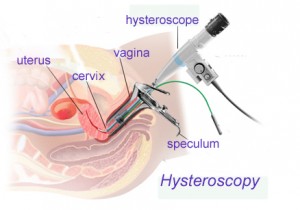Hysteroscopy
 A hysteroscopy is a nonsurgical procedure that is meant either to diagnose or assist in operating on your reproductive system. It is a technique that is used to look at the inside of your uterus. Your gynecologist may request a hysteroscopy if you are having fertility challenges, fibroids, cysts, endometriosis, or a number of other gynecological issues.
A hysteroscopy is a nonsurgical procedure that is meant either to diagnose or assist in operating on your reproductive system. It is a technique that is used to look at the inside of your uterus. Your gynecologist may request a hysteroscopy if you are having fertility challenges, fibroids, cysts, endometriosis, or a number of other gynecological issues.
How does a hysteroscopy work?
A hysteroscopy can be done with your Raleigh OBGYN on site. There are two types of hysteroscopy: diagnostic and operative. In either procedure, a hysteroscopy uses a tiny camera that goes through your vagina, through the cervix, and finally through the uterus. Because the procedure uses your vagina as a passageway to your cervix, there are no incisions involved. The uterus is filled with a fluid that assists the doctor with seeing the uterine wall along with the tubal ostia, or the small openings to where the fallopian tubes enter into the uterus.
As a diagnostic procedure, a hysteroscopy will help your gynecologist to view the state of your uterus and make decisions about what further treatments, if any, are necessary to improve your reproductive health.
An operative hysteroscopy is used as a tool to help correct any gynecological problems at the same time. If your doctor finds that, indeed, you have a gynecological issue, he can decide to perform a minor surgery using small instruments. An operative hysteroscopy can be used to remove polyps, fibroids, adhesions to the uterus, and septums. It can also be used to stop abnormal bleeding during an endometrial ablation.
How do I prepare for a hysteroscopy?
You do not need to go to a hospital to get a hysteroscopy as there is no need for an overnight stay. Once the procedure is complete, you are free to go home and rest. You may be advised to take a mild pain reliever prior to the procedure to lessen the discomfort. You can expect some mild cramping and/or spotting after the procedure. Please arrange to have someone pick you up or take a cab home after your hysteroscopy.
What are the advantages of a hysteroscopy?
In comparison to invasive therapies, a hysteroscopy presents many advantages to women:
- If you are using a hysteroscopy during a gynecological surgery involving a hospital stay, your length of time in the hospital may be shorter.
- Operative hysteroscopies may require a shorter recovery time.
- Women who receive hysteroscopies during surgery usually require less pain medication.
- You may be able to avoid a hysterectomy or other open abdominal surgeries if you receive a hysteroscopy.
If you have questions about whether or not a hysteroscopy will help your condition, please give our office a call.
Is a hysteroscopy a safe procedure?
Yes, a hysteroscopy is considered to be a safe procedure. However there are some risks you should be aware of including the following:
- If you receive anesthesia, there is a small chance of complications occurring
- Infections
- Heavy bleeding
- Cervix, uterus, bowel, or bladder injuries
- Scarring to the uterine tissue
- Allergic reaction to the fluid used to view the uterus
If you experience a fever, severe abdominal pain, or heavy vaginal bleeding after a hysteroscopy, visit emergency care services immediately.
How long does a hysteroscopy take?
A hysteroscopy can take anywhere from five minutes to one hour to complete. The length of time for the procedure is dependent upon whether you are getting a diagnostic or operative procedure. A diagnostic hysteroscopy is shorter in time than an operative hysteroscopy.
As a provider of women’s health care in Raleigh, NC, we at Carolina Women’s Health want to ensure a safe environment for all our patients. We do this by providing as much information as possible about our services and benefits to help you make a decision about your care. If you have questions about having a hysteroscopy, or any other procedure, please do not hesitate to give us a call.
